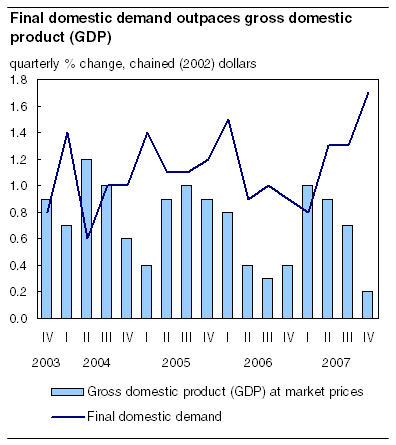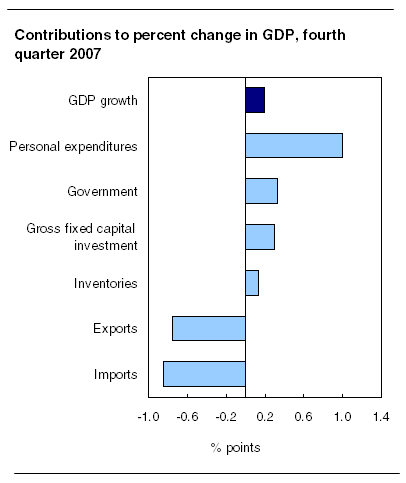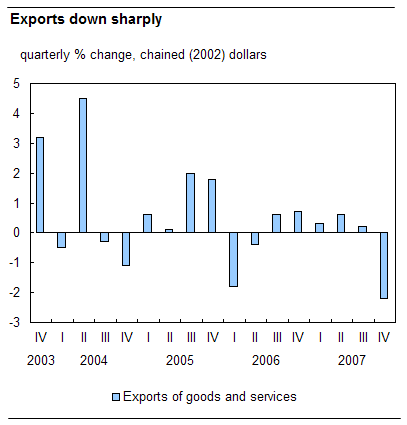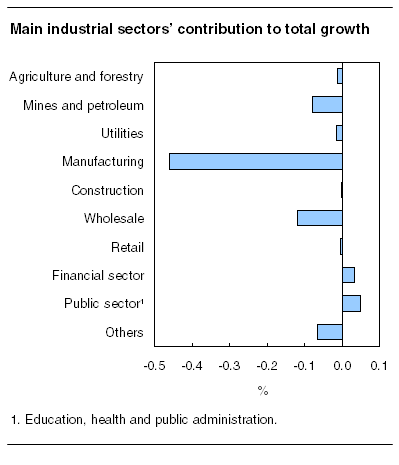Common menu bar links
Canadian economic accounts
Archived Content
Information identified as archived is provided for reference, research or recordkeeping purposes. It is not subject to the Government of Canada Web Standards and has not been altered or updated since it was archived. Please "contact us" to request a format other than those available.

Economic growth slowed considerably in the fourth quarter as real gross domestic product (GDP) grew 0.2%, down from 0.7% in the third quarter. Economic output contracted 0.7% in December.

A more detailed analysis is available in the Canadian Economic Accounts Quarterly Review.
Exports recorded a significant 2.2% decline in the fourth quarter, in the wake of a rising Canadian dollar and extended holiday shutdowns in several motor vehicle manufacturing facilities. Meanwhile, strong growth in final domestic demand and an accumulation of wholesale and retail inventories drove imports up 2.6%. The drop in exports was the first decline in six quarters, as Canada's international trade balance continued to deteriorate in the fourth quarter.
Consumer spending picked up in the fourth quarter of 2007, boosted by a 4.3% jump in motor vehicle purchases, higher travel spending abroad and increased purchases of air transportation. Business investment in machinery and equipment continued at a strong pace.
The output of the service industries expanded 0.7% in the fourth quarter, while the goods-producing industries contracted 0.9%. Wholesale and retail trade, along with utilities, recorded the strongest growth.
The finance and insurance sector, construction, forestry, and accommodation and food services also contributed to the overall increase. These gains were partly offset by declines in manufacturing, mining and selected transportation industries.
Corporate profits were up slightly (+0.5%), well short of the pace set in the previous three quarters. Labour income registered a strong fourth quarter. Employment and average earnings continued to grow in the quarter.
Note to readersPercentage changes for expenditure-based and industry-based statistics (such as consumer expenditures, investment, exports, imports and output) are calculated using volume measures that are adjusted for price variations. Percentage changes for income-based statistics (such as labour income, corporate profits and farm income) are calculated using nominal values, that is, not adjusted for price variations. |
The Canadian economy grew at an annualized rate of 0.8% in the fourth quarter, compared with 0.6% growth for the US economy.
Prices of goods and services produced in Canada advanced 1.1% in the fourth quarter, once again strongly influenced by higher energy prices. Excluding energy, these prices were up 0.7%. Meanwhile, import prices dropped 3.9% in the quarter. This was the third consecutive drop and left import prices 17% lower than in 2002.

Exports of goods down sharply
The decline in exports in the fourth quarter was spurred by a 2.7% decrease in international shipments of goods. Merchandise exports had averaged growth of 0.5% over the previous three quarters.
| Real gross domestic product, chained (2002) dollars1 | |||||||
|---|---|---|---|---|---|---|---|
| Change | Annualized change | Year-over-year change | |||||
| % | |||||||
| First quarter 2007 | 1.0 | 4.0 | 2.1 | ||||
| Second quarter 2007 | 0.9 | 3.8 | 2.6 | ||||
| Third quarter 2007 | 0.7 | 3.0 | 3.1 | ||||
| Fourth quarter 2007 | 0.2 | 0.8 | 2.9 | ||||
| 2007 | 2.7 | ... | 2.7 | ||||
| |||||||
The drop in the export of goods was widespread. Exports of machinery and equipment as well as automotive products continued to be weak, falling 3.4% and 1.7% respectively. Industrial goods and materials (-2.7%) also declined, following two consecutive quarters of growth.
Consumer expenditure picks up
Consumer expenditure advanced 1.8% in the fourth quarter, up from a 1.1% increase in the third quarter.
A large jump in travel spending abroad contributed about half of the 2.1% growth in spending on services. This was the third consecutive large quarterly increase in net expenditure abroad, and reflected a surge in expenditures in the United States as well as other countries.

Durable goods, led by strong motor vehicle purchases, advanced 2.9%.
Housing investment slows
Business investment in residential construction grew 0.6% in the fourth quarter, less than half the pace of the third quarter (+1.4%). This was the fourth consecutive quarterly increase. Most of the slowdown in the quarter was the result of lower activity in the resale market (-2.6%), the second consecutive decrease.
Non-residential construction edges up
Business investment in buildings and engineering projects edged up in the fourth quarter, following two quarterly declines. Business spending on engineering projects slowed significantly in 2007 following double-digit increases in the previous two years.
Business investment in machinery and equipment still strong
Investment in machinery and equipment advanced 3.4% in the fourth quarter, similar to the 3.3% pace set the previous quarter. Except for the first quarter decline, investment in machinery and equipment has posted continuous quarterly growth since the beginning of 2003. The gain in investment in the last two quarters resulted in a 2.5% surge in imports of machinery and equipment on top of the 6.4% rise in the third quarter.
Large build-up of inventories
The last half of 2007 saw two large quarterly build-ups in inventories with a fourth quarter rise in inventories worth $19 billion, higher than the $16 billion accumulation in the previous quarter.
Retail and wholesale durable goods accounted for about half of the accumulation. Manufacturing inventories were drawn down and farm inventories were sold off as farmers cashed in on high grain prices.
Corporate profits level off
Corporate profits were up slightly in the fourth quarter (+0.5%), well short of the pace set in the previous three quarters.
Higher profits in the retail and wholesale trade industries offset lower manufacturing and mining profits. Corporate profits of financial institutions declined slightly in the fourth quarter.
Labour income pushes upward
Labour income registered a strong fourth quarter, up 1.8%, a marked acceleration from the third quarter growth of 0.4%. Mining and utilities pushed up wages in goods-producing industries (+1.9%), while education and health care contributed to growth in service producing industries (+1.7%).
Government transfers to persons moderated in the fourth quarter (+0.7%), after a strong third quarter.
An increase in personal income, combined with modest growth in income taxes, resulted in a 1.6% increase in personal disposable income. The personal saving rate slipped to 0.8% in the fourth quarter with higher personal spending.
Household debt in the form of mortgages and consumer credit edged up to 116.4% of personal disposable income. Debt servicing charges remained unchanged at about 8% of personal disposable income.
Gross domestic product by industry, December 2007
Economic output contracted 0.7% in December, after increasing 0.1% in November and 0.3% in October. Significant reductions in manufacturing activities, wholesaling, as well as in oil and gas extraction were the main sources of the December decline. Modest gains were recorded in mining, excluding oil and gas, and the financial sector, while construction remained unchanged.

Manufacturing activity tumbled 3.2% in December, reaching its lowest level since December 2001. Motor vehicle production dropped 27%, the largest monthly decline since production cutbacks in January 1990 caused a 37% reduction in activity. The major drop in motor vehicle production in December was primarily due to extended holiday shutdowns related to inventory control and retooling for new models. Excluding motor vehicle and parts production, economic output contracted 0.4% in December. Preliminary information for January 2008 indicates a partial rebound in motor vehicle production from its December level.
Declines in the manufacturing sector were widespread, with 17 of the 21 major groups decreasing. Both the manufacturing of durable (-4.8%) and non-durable goods (-0.9%) fell. Other notable drops were recorded in wood products, machinery, and non-metallic mineral product manufacturing.
Some transportation industries were affected by the downturn in manufacturing, such as rail and truck transportation, as was the wholesale trade sector.
Wholesaling activities fell 2.0% in December. This decline was largely due to the fall in the trade of automotive products, food and beverage products, and machinery and electronic equipment. Value added in the retail trade sector edged down 0.1%.
The energy sector slipped 1.2% in December. The oil and gas extraction industry contracted 1.7%, dragged down by a decrease in petroleum extraction. The production of electricity fell 1.2% in December.
Industrial production (the output of mines, utilities and factories) dropped 2.4% in December, with all three sectors declining. In the United States, industrial production edged up 0.1% in December as manufacturing increased, while mining and utilities contracted.
The construction sector was unchanged in December, as activity may have been restrained by heavy snowfalls in some parts of the country. The increases in non-residential building construction (+0.1%) and engineering and repair work (+0.1%) were neutralized by the 0.4% decline in residential construction. The home resale market continued to cool. As a result, the real estate agents and brokers industry fell 2.1% for the month.
Year-end review
Real GDP grew 2.7% in 2007, a slight deceleration from 2006. The growth rate for 2007 matches the average growth of the past five years. The economy slowed over the course of 2007 with the lowest growth recorded in the fourth quarter.
The year was marked by a further large appreciation of the Canadian dollar with respect to the US currency. Imports surged ahead while exports edged up at a pace similar to 2006. Personal income and consumer spending remained strong as final domestic demand advanced 4.3%.
Finance and insurance, retail and wholesale trade, and construction were the main sectors contributing to growth in 2007. The energy sector also continued to expand with growth being restrained by a reduction in support activities for mining and oil and gas extraction (which includes exploration).
Although it started the year on a positive note, manufacturing was once again hit hard in 2007 (-1.1%) with decreases in both durable and non-durable goods producing industries. Significant declines were also experienced in forestry and logging and their associated support activities.
Consumer spending, up 4.7% in 2007, was a driving force in the economy. This was the largest gain since 1985. Strong employment and income growth, along with low inflation and low interest rates kept conditions favourable for consumers.
Travel spending continued to push expenditures on services up in 2007. Travel spending abroad registered another large increase with the strong Canadian dollar making travel to foreign destinations more attractive.
Business investment in residential construction contributed to overall growth as it increased 3.2% in 2007, a slight pickup from 2006.
Businesses continued to invest heavily in plant and equipment in 2007, up 4.4%, adding another year to the string of substantial increases.
Business investment in machinery and equipment grew 5.1% in 2007, down from increases of more than 7.0% in 2005 and 2006.
Corporate profits maintained steady growth in 2007 up 5.8%, slightly above growth of 5.0% in 2006.
Exports edged up in 2007, while imports registered another strong year of growth (+5.7%), the fourth consecutive year that growth was five percent or more. Although Canadian international exports continued to benefit from high commodity prices, the trade surplus narrowed in nominal terms.
Inventories continued to accumulate in 2007 ($11 billion), just above the level recorded in 2006 ($10 billion).
Labour income grew 6.1% in 2007, little changed from 6.2% in 2006.
Prices of goods and services produced in Canada advanced 3.1% in 2007, up from 2.4% in 2006. Import prices declined 2.2% resulting in a level that was 12.5% lower than in 2002, reflecting the continued appreciation of the Canadian dollar.
Products, services and contact information
Detailed analysis and tables
The National economic accounts module, accessible from the home page of the agency's website, features an up-to-date portrait of national and provincial economies and their structure.
More detailed analysis on today's releases from the national accounts, including additional charts and tables, can be found in the fourth quarter 2007 issue of Canadian Economic Accounts Quarterly Review, Vol. 6, no. 4 (13-010-XWE, free) from the Publications module of our website.
Gross domestic product by industry
Available on CANSIM: table 379-0027.
Definitions, data sources and methods: survey numbers, including related surveys, 1301, 1804, 1901 and 2602.
The December 2007 issue of Gross Domestic Product by Industry, Vol. 21, no. 12 (15-001-XWE, free) is now available from the Publications module of our website.
For general information or to order data, contact our dissemination officer (toll-free 1-800-887-4623; iad-info-dci@statcan.gc.ca). To enquire about the concepts, methods or data quality of this release, contact Bernard Lefrançois (613-951-3622), Industry Accounts Division.
National economic and financial accounts
Available on CANSIM: tables 378-0001, 378-0002, 380-0001 to 380-0017, 380-0019 to 380-0035, 380-0056, 380-0059, 380-0060 and 382-0006.
The fourth quarter 2007 issue of National Income and Expenditure Accounts, Quarterly Estimates (13-001-XIB, free) will soon be available.
Detailed printed tables of unadjusted and seasonally adjusted quarterly National Income and Expenditure Accounts (13-001-PPB, $54/$193), Financial Flow Accounts (13-014-PPB, $54/$193) and Estimates of Labour Income (13F0016XPB, $22/$70), including supplementary analytical tables and charts are now available.
At 8:30 a.m. on release day, the complete seasonally adjusted quarterly National Income and Expenditure Accounts (13-001-DDB, $134/$535), Financial Flow Accounts (13-014-DDB, $321/$1,284), and monthly Estimates of Labour Income (13F0016DDB, $134/$535) data sets can be obtained on computer diskette.
These diskettes can also be purchased at a lower cost seven business days after the official release date (13-001-XDB, $27/$107; 13-014-XDB, $65/$257; and 13F0016XDB, $27/$107). To purchase any of these products, contact Client Services (613-951-3810; iead-info-dcrd@statcan.gc.ca), Income and Expenditure Accounts Division.
For more information, or to enquire about the concepts, methods or data quality of this release, contact the information officer (613-951-3640, iead-info-dcrd@statcan.gc.ca), Income and Expenditure Accounts Division.


 Table(s).
Table(s).